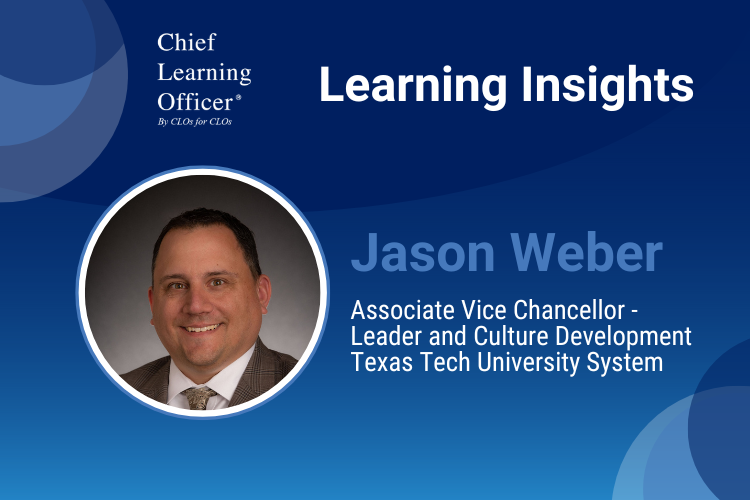Chief Learning Officer’s “Learning Insights” series is dedicated to showcasing the thoughts and career journeys of chief learning officers and learning executives – the tireless trailblazers who are transforming the landscape of corporate learning and workforce development. In this Q&A series, we garner strategic insights, innovative approaches and challenges overcome from visionary leaders worldwide.
What initially drew you to a career in L&D, and how have your experiences evolved over the years?
It was actually a career change for me. I was at a point where I was miserable in the work I was doing. A mentor encouraged me to find what I was really passionate about. For me, it was people development.
I made a career change into people development 15 years ago and have loved every minute. Since making the change, I have gone from a staff development specialist to a training director to an associate vice president and am now an associate vice chancellor focusing on leader and culture development for five universities totaling 83,000 students, faculty and staff.
“If we want to continue to be effective, we must continuously be learning.”
What key initiatives have you implemented as a learning leader to drive employee development and foster a learning culture?
The largest initiative I have had the opportunity to lead is the shared services implementation for the state of Wisconsin. As the enterprise training director for the state of Wisconsin, I was tasked with creating a training and development model that would serve 21 state agencies and 40,000 employees. This initiative required writing a memorandum of understanding with each of the state agencies, bringing together training staff from 17 of the 21 state agencies and creating training that was enterprise-focused. In this role, we created a regional support model that included staff development specialists and instructional designers. We were able to successfully implement enterprise-wide training initiatives that created consistency and collaboration opportunities between agencies.
What is the most impactful learning program you’ve introduced in your organization, and how has it contributed to employee growth and business success?
Recently, I had the opportunity to introduce a new program called the Next-Level Leader Development Program. Designed for mid- to senior-level leaders, the program was designed to provide them space to better understand who they are as a leader.
We know that many times leaders will be moved into senior/executive-level roles only to burn out or lose their sense of self. This program allows leaders to come together to focus six months on self-reflection and self-development. Courses are run using the Socratic methods — meaning there is no technology used, only questions offered to explore how they aspire to impact others.
Results from this program have shown stronger, more confident leaders being placed into roles with more responsibility. Participants have been promoted at a higher rate than those in other programs.
What is a common misconception people might have about the L&D function, and how do you address it?
A misconception I have observed is that completing leader development programs ensures people will be promoted. For us, we tell employees if they are seeking a certificate, our programs are not for them. We do ask employees for recommendations from leaders and peers, and we emphasize our development on the whole person. We then partner with HR to offer task-specific training, but the majority is focused on how they can grow their emotional intelligence, team development, conflict management and decision-making.
Yes, employees who have completed our programs have been promoted, but we want employees who desire to grow as a person rather than employees who are seeking a title.
What excites you the most about the future of workplace learning, and how are you preparing your organization to adapt to the changing landscape?
I have really enjoyed the acceptance and transition toward technology. We have been able to offer more learning through the use of technology. I am seeing employees’ perceptions and needs change around how they receive the training. We are able to offer training when it is most needed, and this is thanks to technology. Our organization still places a role on face-to-face interactions, but they are supplemented through technology.
What essential qualities or skills make a successful L&D leader, and how do you cultivate these traits in yourself and among your team?
Curiosity and collaboration are so important. In my career, I have been placed in many situations where I had to be curious to figure out a new solution and then I had to be able to collaborate to move things forward. Consistently, these are the two skills I would encourage any learning leader to develop. For me, I focus on developing this through learning. I am constantly reading new books, attending webinars and talking with other learning leaders.
A mistake I have observed is learning leaders not focusing on their continuous development. It doesn’t matter the level or role; if we want to continue to be effective, we must continuously be learning.
What game-changing advice would you offer if you could go back in time and mentor your younger self?
Find what gives you energy and do it. There are so many variations of people development out there. Be willing to try new variations of training to find what really works for you.
Looking back on my career, there were many signs where I knew people development was what I wanted to do, but I was worried about being able to make a career out of it. However, when I made the change, more and more opportunities came to me. Be open and willing to try new things.
What do you feel is currently the single biggest challenge facing L&D professionals and the industry as a whole?
Buy-in. Does people development have a voice with the president or CEO of your organization? Many companies say that people are their most important asset, yet they have people development buried in the organizational chart. The less engagement we have with executive leaders, the less buy-in we will receive. We need to be able to remind our organizations that people development is essential to help the organization remain flexible to all of the changes we see.
We’re always looking to showcase innovative tools and technologies. Can you share one work or learning tech product or platform that has significantly improved your work processes and why you find it valuable?
Slido has been an effective tool for our organization. Slido is a real-time polling tool that allows the trainer to use polls, word clouds, open responses and many other tools when working with a group.
One of the best pieces of feedback I have received when using Slido is from an employee who stated they did not feel safe or comfortable sharing their opinions in the group. Slido gave them a safe method for sharing their opinions with the group.
When we use Slido, we consistently see 98 to 100 percent engagement. When I don’t use it, I am only seeing 30 to 40 percent engagement.
Interested in being featured in our “Learning Insights” series? Please complete this FORM.















